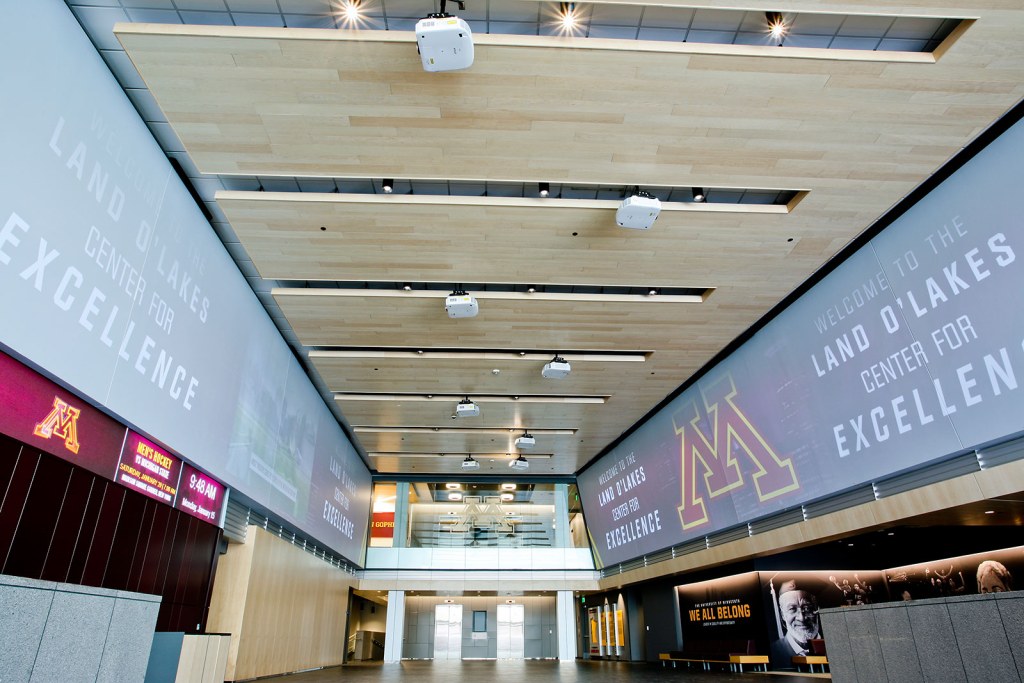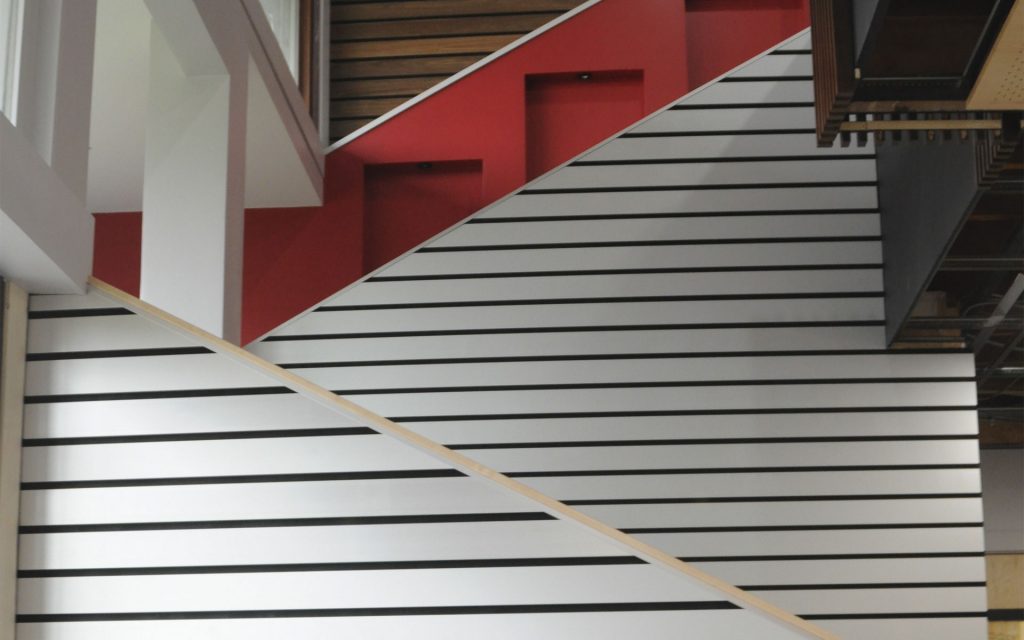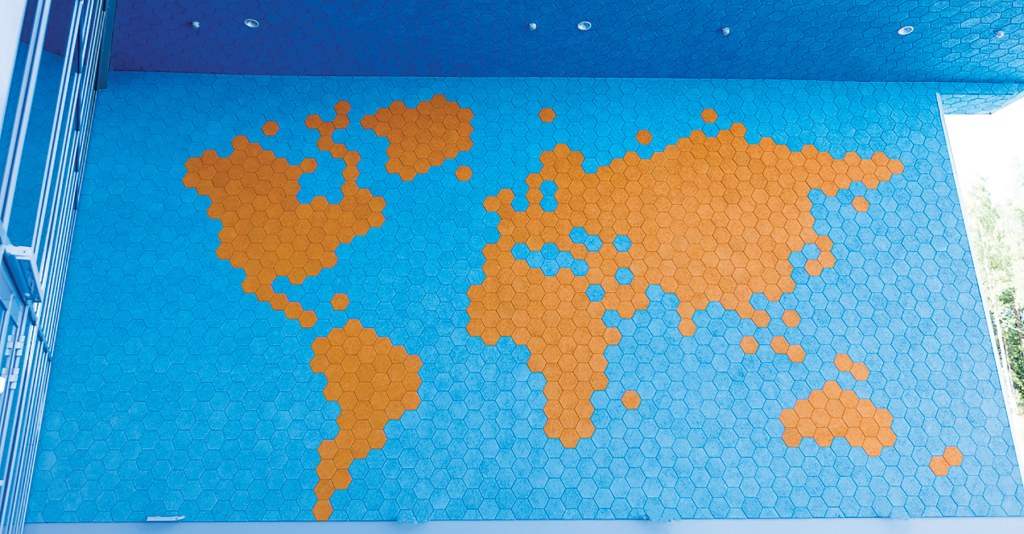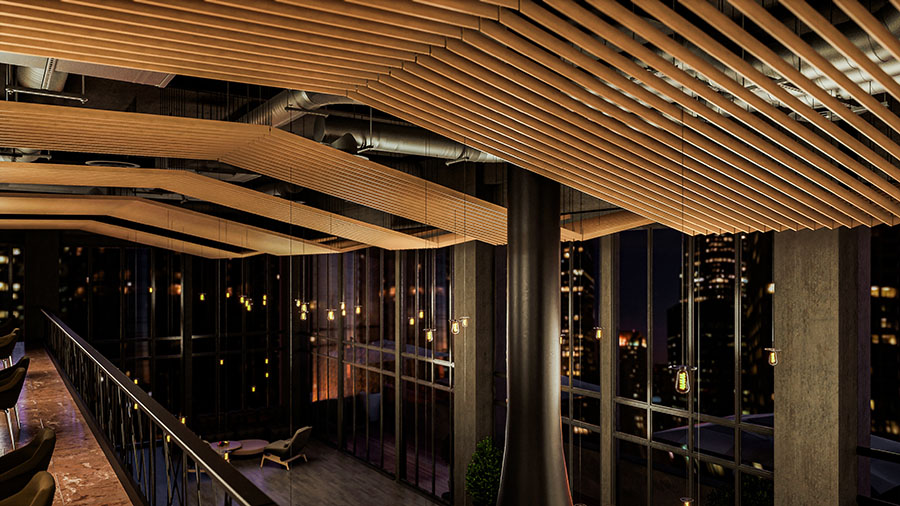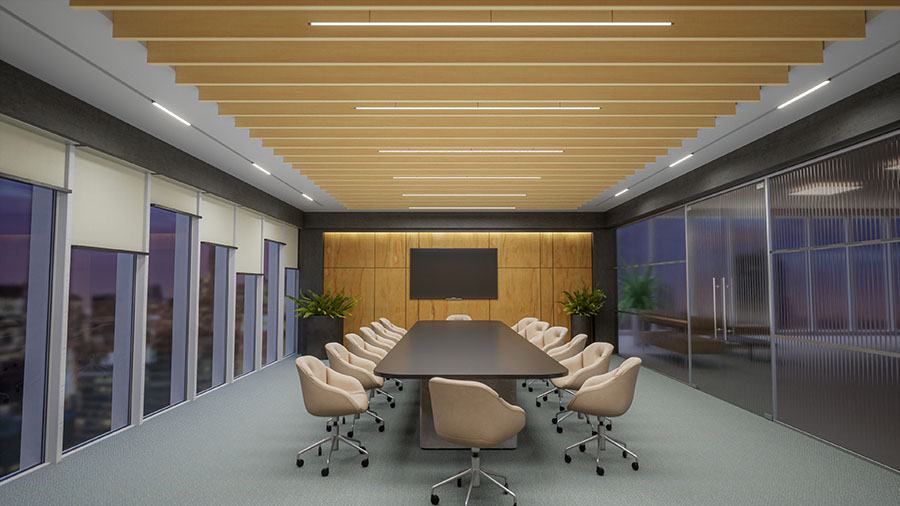
Functional Art: The Role of Texture in Acoustics & Building Materials
In contemporary interior design, acoustic textures are becoming essential tools for shaping how spaces look, feel, and sound. Architects and designers increasingly recognize that textured acoustic panels and other tactile architectural materials do more than just decorate–they guide light and shadow, influence emotional responses, and manage sound to enhance comfort and performance.
From slatted wood wall panels that bring warmth and rhythm to a room, to microperforated wall panels and perforated panel designs in metal or resin, acoustic textures transform interiors into multisensory experiences. Carefully chosen ceiling and wall textures help create environments that are visually compelling and acoustically optimized, offering both technical performance and sensory richness. This reflects the growing importance of sensory design in architecture, where material tactility and acoustics work together to shape experience.
While visual and acoustic qualities of a space are immediately noticeable, texture offers a subtler kind of influence. It mediates how surfaces interact with light, how sound waves move through a room, and how occupants physically and emotionally engage with their surroundings. Recognizing texture as a deliberate design choice allows architects to move beyond decoration, treating walls and ceilings as instruments that shape experience as much as structure. This perspective sets the stage for exploring texture as a key design tool.
Texture as a Design Tool
Texture serves as one of the most expressive tools in an architect’s material palette, shaping how light and shadow play across surfaces, setting the tone for warmth or coolness, and influencing the emotional and sensory experience of a space. When thoughtfully applied, textured acoustic panels influence both how a room looks and how it sounds, making surfaces active participants in the overall experience. This is especially true with acoustic ceiling systems, where surface pattern and depth enhance both sound control and spatial character.
Beyond its aesthetic role, texture guides perception and interaction. Linear patterns, perforations, and layered surfaces create rhythm and visual interest, while tactile finishes invite physical engagement. In spaces such as classrooms or healthcare facilities, these surfaces can offer subtle sensory cues, enhancing comfort or focus. In hospitality and luxury interiors, texture contributes to atmosphere, sophistication, and a sense of quality.
By considering texture as a primary design element rather than a finishing touch, architects can craft interiors that balance artistry with function. The combination of surface pattern acoustics, material tactility, and visual depth allows spaces to feel more intentional, responsive, and multisensory–demonstrating that texture is as much about shaping experience as it is about decoration.
Common Textured Materials: Wood, Metal, Resin
Material choice defines not only the visual language of a space but also its acoustic performance. Each surface brings its own tactile qualities and ability to shape sound, which is why acoustic textures are such an important part of modern design. ASI Architectural’s portfolio reflects this variety, offering systems in wood, metal, and resin that combine technical depth with architectural beauty.
Wood
Wood has long been a benchmark for warmth and authenticity in interiors. Its natural grain provides subtle variation, while slatted assemblies create rhythm and order. ASI’s Grille and Linear Plank systems use this language of repetition to deliver both acoustic control and visual richness. For a more refined approach, Microperf technology introduces thousands of nearly invisible perforations, allowing wood to function as a high-performance surface, reinforcing the role of wood acoustic surfaces in creating warm yet technically advanced interiors. Whether in ceilings or slatted wood wall panels, wood remains one of the most effective and versatile textured acoustic panels.
Metal
Metal surfaces introduce a different character–sleek, precise, and durable. Through perforations, ribs, or geometric grids, ASI’s Fusion line of metal panels blends industrial strength with architectural expression. When paired with acoustic backing, these perforated panel designs help diffuse and absorb sound while creating dynamic shadow patterns. The result is a material that works as well in a contemporary workplace as it does in transportation or civic environments where resilience is key.
Resin & Composites
Resin and composite systems broaden the acoustic design palette with sculptural, soft-touch, or translucent surfaces. ASI’s Baffle Systems and StrandTec panels leverage irregular textures and porous structures to deliver powerful sound absorption. In healthcare and educational spaces, these materials provide sensory comfort and clarity. In hospitality or cultural venues, they allow bold, statement-making forms that interact with light and atmosphere.
Together, wood, metal, and resin illustrate how decorative acoustic panels can be both functional and expressive, underscoring the role of architectural panels and material tactility in shaping multisensory environments.
Visual vs. Tactile Texture in Wall and Ceiling Systems
Texture influences interiors in two distinct but overlapping ways: what we see and what we touch. Visual texture comes from patterns, shadows, and depth perceived by the eye–like the rhythm of slatted wood or the geometry of perforated metal. Tactile texture is experienced through the hand, where grooves, fabric, or soft-touch surfaces invite direct interaction. Both dimensions matter in spaces designed to engage people fully.
In his book The Eyes of the Skin, architect and former professor of architecture at the Helsinki University of Technology Juhani Pallasmaa argues that “the skin reads the texture, weight, density, and temperature of matter,” reminding us that design is not only about appearance but about multisensory experience.
Similarly, Peter Zumthor notes how material presence can evoke memory and atmosphere. Applied to ceilings and walls, these ideas highlight how tactile architectural materials and material tactility in interiors shape our understanding of space beyond visual impressions.
ASI’s systems illustrate this balance. Grille or Linear Plank panels provide visual rhythm overhead, while in lower wall applications, their wood surfaces invite touch and convey natural warmth. Fusion metal panels rely on shadow play and precision lines to create visual intrigue, while Microperf wall panels offer subtle texture that reads as a refinement to the eye but functions acoustically in measurable ways. In contrast, StrandTec or Baffle Systems bring more pronounced tactility, their layered fibrous surfaces delivering both sensory richness and high-performance acoustics.
In education or healthcare settings, tactile engagement can comfort or stimulate occupants through subtle sensory cues. In hospitality or cultural environments, interactive interior materials–panels designed to respond visually, acoustically, or through touch–elevate the atmosphere while encouraging users to engage with the space, creating a richer sensory experience. By designing with both visual and tactile texture, architects create environments that honor not just how spaces look, but how they feel and sound.
How Texture Enhances Acoustic Performance
A large part of what makes acoustic materials so adept at improving acoustics is their texture. In fact, acoustics are largely related to the specific textures that exist in any space. Smooth, reflective surfaces like glass or concrete allow sound to bounce freely, creating echoes and reverberation. By contrast, rough, porous, or irregular surfaces scatter and absorb sound energy, softening the acoustic environment and improving clarity.
This principle explains why acoustic textures–from grooves and perforations to fibrous finishes-are so effective. Slatted wood panels, for example, not only create visual rhythm but also interrupt sound waves, reducing unwanted resonance. Microperforated wall panels with an acoustical backer go a step further. Thousands of near-invisible holes allow sound to pass through to an absorptive core, delivering high performance without compromising a clean aesthetic.
Depth also matters. Systems with ridges, layers, or baffles enhance diffusion, scattering sound across a wider spectrum of frequencies. ASI’s StrandTec panels, with their fibrous texture, and Baffle Systems, with their suspended geometry, both demonstrate how material tactility directly translates into sound absorbing textures that perform at scale. This link between form and function reflects the principles of natural material acoustics, where inherent surface qualities drive performance.
Understanding these relationships allow architects to see texture not as a surface decoration but as acoustic infrastructure. Every groove, ridge, or perforation plays a role in how sound behaves. By specifying modern acoustic materials that merge visual depth with acoustic science, designers create interiors that perform as beautifully as they look.
Designing with Texture: What Architects Should Consider
When specifying textured materials for ceilings and walls, architects balance visual intent with acoustic performance, durability, and user experience. Treating texture as a primary design driver rather than a finishing layer helps ensure it supports both form and function. A few considerations stand out:
Cohesion with the Palette
Textures should integrate with the broader material story of a space. Slatted wood wall panels might emphasize warmth and rhythm, while perforated metal offers precision and contrast. The key is ensuring that texture amplifies the design narrative rather than competing with it.
Performance in Context
Spaces like classrooms, auditoriums, or open offices demand different acoustic strategies than luxury lobbies or healthcare facilities. Designers should evaluate whether textured acoustic panels are needed primarily for sound absorption, diffusion, or a combination of both, then select materials accordingly.
Longevity and Cleanability
In high-traffic or healthcare environments, tactile architectural materials must withstand wear and remain hygienic. Smooth finishes may be easier to clean, while fibrous or highly textured panels can be more sensitive but offer superior sound absorbing textures.
Lighting and Shadow Play
Directional lighting can accentuate grooves, ribs, or perforations, turning acoustic elements into decorative focal points. Considering how daylight and artificial light interact with textures ensures the material feels intentional across different times of day. This is particularly powerful when working with a textured wood ceiling, where light enhances grain and depth.
User Interaction
Textures within reach–such as wall panels in corridors or waiting areas–invite touch. This tactile quality can add comfort, interest, or sophistication, but also raises questions of durability and finish quality.
By weighing these factors early in the design process, architects can specify ceiling and wall textures that deliver acoustic value, align with aesthetic goals, and support user experience. The result is an interior where material tactility and surface pattern acoustics are integral to performance, not afterthoughts.
The ASI Approach: Materials That Speak to the Senses
At ASI Architectural, texture is never an afterthought–it’s the foundation of performance and design. Every ceiling and wall system we create is engineered to deliver not only measurable acoustic results but also a distinct sensory presence. Our portfolio highlights the versatility of modern acoustic materials:
- Grille and Linear Plank Systems bring rhythm and tactility, offering warmth and architectural depth.
- Microperf and Fusion Panels provide refined, almost invisible perforations for subtle elegance with acoustic impact.
- StrandTec and Baffle Systems deliver bolder visual character and high-performance sound absorption for large, dynamic spaces.
Each system demonstrates our commitment to material tactility, sustainability, and customization. Whether the design intent is to create a calming healthcare environment, a sophisticated hospitality interior, or an energetic educational setting, ASI offers solutions that merge decorative panels with acoustic precision.
Ultimately, the value of our work lies in creating environments that feel as good as they sound. By combining architectural texture design with technical expertise, ASI enables designers to craft spaces that are visually compelling, acoustically comfortable, and materially enduring. For architects and designers seeking to elevate projects with ceiling and wall systems that truly engage the senses, ASI Architectural offers the path forward–through innovative, sustainable, and beautifully crafted acoustic textures.
Explore our samples, request a consultation, or visit our digital gallery to experience firsthand how ASI’s materials can transform your next project.





